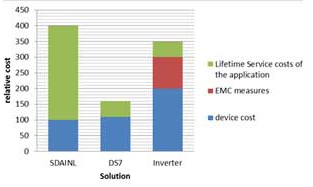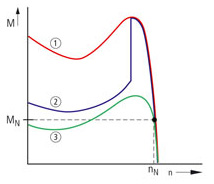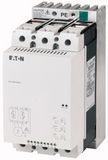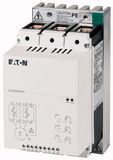|
DS7
Mains connection:
230 – 480 V ±10 %, 50/60 Hz
Control voltage:
24 V AC/DC / 110 – 230 V AC
Rating range:
4 – 32 A (1,5 – 15 kW at 400 V)
41 – 200 A (22 – 110 kW at 400 V)
Power feature:
- AC53b, inductive load with internal bypass, 10 starts per hour with 3-fold starting current for 5 seconds
- Higher number of starts per hour with optional fan
Savings potential:
The reduction of peak-currents and the lower wear of the machine ensures that you get the following comparison between conventional solutions, Soft Starters and Frequency Inverters.
Service costs include costs for device change of aged contactors, belts and gear boxes as well as the cost for different peak load costs.

Motor voltage – soft start

With the soft starter, gating control is used to reduce the motor voltage, then within a predetermined ramp-up time (tSTART), is raised to the mains voltage from an easily-set starting voltage (USTART). In this way, the smooth starting and stopping of the motor protects the mechanical devices connected to it from being subjected to the load with a jolt, and it prevents current peaks and therefore voltage dips in the electrical supply network.
Motor torque – reduced load

Current and voltage fluctuations during start-up can lead to problems in the network. The resulting abrupt torque fluctuations place stress on machines, necessitating service work and influences on production quality. A soft starter allows you to minimise these disadvantages. It ensures a smoother torque characteristic and reduces your operating costs.
Motor current – damping current peaks

Power supply companies are demanding increading adherence to certain current limits. The aim is to avoid overloading the network due to high inrush currents during direct-on-line starting or current peaks during star-delta starting, in order to prevent unpleasant side effects such as voltage dips. Since the current limit can be set on soft starters DS7-34D…, they provide the ideal solution.
|























